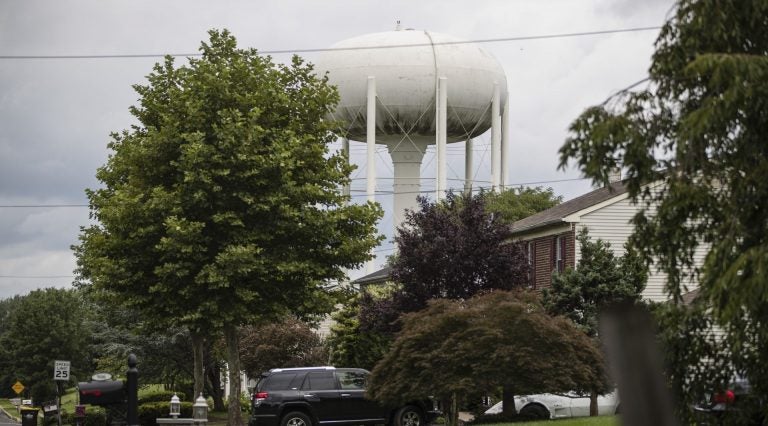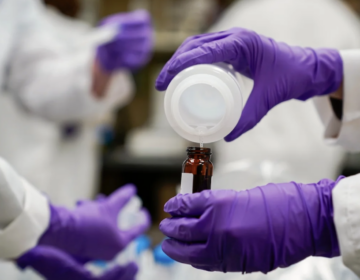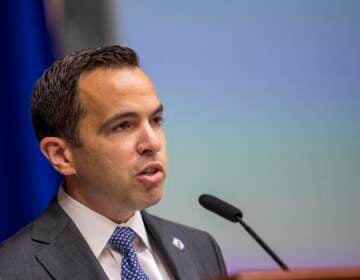Congress eyes ban on firefighting foams that have tainted drinking water in the Philly region
A Senate bill would phase out the foams on military installations by the end of 2023, but a House proposal wouldn’t do so until 2029.

In this Aug. 1, 2018 photo, a water tower stands above a residential neighborhood in Horsham, Pa. (Matt Rourke/AP Photo)
Congress is set to phase out the military’s use of firefighting foams that contain a class of toxic chemicals called PFAS, which has been linked to various health conditions and has contaminated drinking water in states like Pennsylvania, New Jersey and Delaware.
The Senate version of an annual military funding bill would ban the foams on military installations in 2023, while the House version would do so in 2029.
Lawmakers have also proposed a $121 million allocation for the cleanup of contaminated sites on or near military bases as part of the National Defense Authorization Act, or NDAA.
Environmental groups called the proposals a welcome but modest first step in addressing a much larger problem.
Scott Faber of the Environmental Working Group, a national advocate for stricter limits on PFAS chemicals, said firefighting foams are just one of the big sources of the toxic compounds.
“There are hundreds of industrial facilities that are still legally discharging PFAS straight into the air, straight into the water with no restrictions whatsoever,” he said, adding that the chemicals have also made their way into the food supply.
Tracy Carluccio, deputy director of the Delaware Riverkeeper Network, said there’s no reason to wait four or 10 years to phase out the use of the firefighting foams.
“They should do it immediately,” she said. “We know there’s been years of study into this and we know that the military has actually known about toxic properties associated with these foams for decades.”
PFAS, short for perfluoroalkyl and polyfluoroalkyl substances, have been used since the 1940s and have been linked to health conditions including high cholesterol, thyroid disease, low birth weights, immunodeficiencies and some cancers.
In addition to their widespread use in firefighting foam — deployed by the military to battle jet-fuel fires — they are found in household goods ranging from nonstick pans to dental floss.
Although some PFAS chemicals have been phased out by U.S. manufacturers, they do not break down in the environment or the body and are still found in some water sources near sites where they have been produced or used.
As concern about exposure has grown, federal lawmakers have introduced at least 15 bills this year to try to better understand and combat the problem. The military spending bill could be amended in the weeks ahead to incorporate some of those proposals.
But thus far the federal response has paled in comparison to the scope of the chemicals’ impact, affecting hundreds of locations across 43 states, according to data compiled by the Environmental Working Group.
The Environmental Protection Agency has yet to establish mandatory federal limits for PFAS contamination in drinking water, making it harder for many communities to start cleanups and protect against the compounds. In the absence of federal regulations, some states, like New Jersey, have set their own health limits for the chemicals or started to develop them.
In Pennsylvania, concern has focused on Horsham in Montgomery County and Warrington and Warminster in Bucks County, where high PFAS levels have been found in public and private water systems near two former military bases that used the chemicals in firefighting foam for decades.
Elevated levels have also been recorded at dozens of sites in New Jersey, including Joint Base McGuire-Dix-Lakehurst in Burlington County, and in Delaware around the New Castle Air National Guard Base and elsewhere.
The House and Senate are expected to reach a compromise in the coming weeks on how to phase out the problematic firefighting foams. Faber said he was confident the faster timeline would win out.
“Everyone agrees that we should end the military use of fluorinated foams as soon as possible, so I’m very optimistic that the final bill will have the more aggressive deadline,” he said.
Any money allocated for environmental remediation will likely be a tiny fraction of what experts estimate is needed to properly address the problem.
A Defense Department official recently estimated it would take $2 billion to remediate the hundreds of military bases where PFAS was used, while other witnesses who testified before a House panel said that cleaning up the chemicals nationwide would cost tens of billions.
WHYY is your source for fact-based, in-depth journalism and information. As a nonprofit organization, we rely on financial support from readers like you. Please give today.





